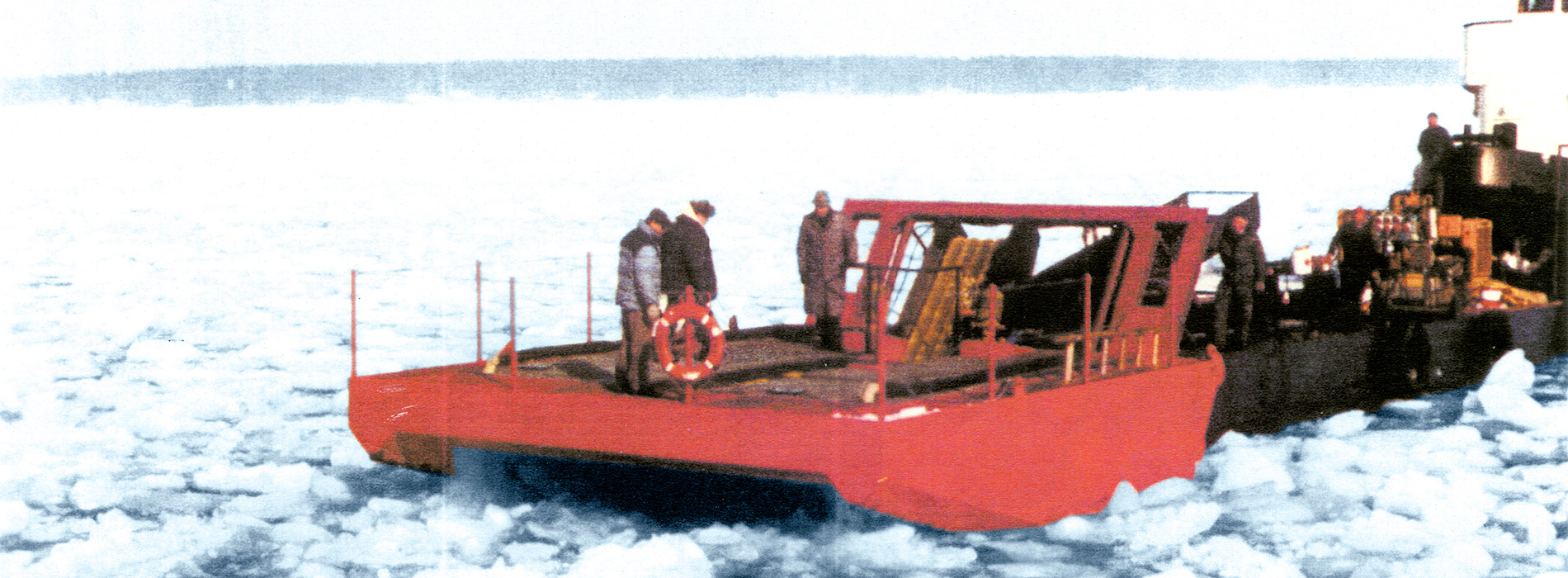OIL RECOVERY IN ICE 1987 – 1988
A floating bow structure which is pushed through broken ice by a tug. While passing over the ice, a special brushing and water pumping process takes place. Oil is removed from the ice mass and only cleaner ice exits from under the ice cleaner.

New ice cleaner


ABOUT THE NEW ICE CLEANER COLLECTOR
We cast our minds back to 1987, when the world’s first mechanical stiff-brush oil collecting system for icy conditions (ICE CLEANER) built and owned by Lars Lundin was in operation in connection with the M/T ANTONIO GRAMSCI oil spill.
The collector’s special features included its good ability to operate in ice: to hydraulically change its angle of tilt forwards and backwards in relation to the surface of the water, and the location of its controls on a mesh deck. Since the controls were located on a mesh deck, it was possible to visually follow the collector’s operations and the behaviour of the oil inside the collector. In this way information was obtained on the behaviour of the brushes and the maximum capacity of the collector. The collector worked flawlessly in the prevailing conditions surrounding the M/T ANTONIO GRAMSCI oil spill. The only issue when collecting the oil was the presence of small pieces of ice.
The collector was 6.5 metres wide, 5 metres long, and weighed 4.3 tons.
As a result of the project, changes were made to the collector, but later they proved to be poor. The collector lost its good operational ability and features. At this phase, the authorities were informed that this was a poor solution. Nevertheless, it was decided that the collector would be built based on the modified collector. Lars Lundin remembers that the Wärtsilä dock’s planning group were added to the project, and everything was big. The biggest damage to the collector occurred when a decision was made that the collector had to be adapted to all ice-faring vessels commanded by the Finnish Environment Institute.
After the M/T ANTONIO GRAMSCI operation the authorities announced their interest in the collector. The wanted to be involved in a project to lengthen the collector and increase its collecting capacity
This decision sealed the fate of Lars Lundin’s original collector, as it lost its particularly valuable ability to operate on ice. The result was the construction of a pusher-like floating device, which swam like a frog. It weighted 25 tons and had a negligible collecting capacity. The collector was hidden away somewhere in Western Finland, and the technological publicity developed over two years by Lars Lundin was lost.
New Ice Cleaner combined with Tug boat


NEW ICE CLEANER
In his later years, Lars Lundin decided to solve the problem with small pieces of ice and continue the modernisation of his original collector. He is also convinced that the use of a tug boat is the best solution when collecting oil in ice; all modern tug boats are made to traverse even thick ice well. They are in a class of their own when compared to icebreakers. The use of a tug is unbeatable in harbour areas and in waters which are difficult to navigate.
A completely new innovation is the ability of the ice brush – installed on the tug – to leave small pieces of ice and slush in the water, as well as its special ability to collect very heavy oils and other property-changing oils. In addition, the brush drum’s property of emptying its interior space of water guarantees good collection. The collector is equipped with two oil transfer systems; one for crude oil and another for heavy oils, which possibly contain slush.

